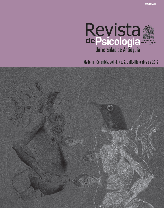Consistência interna e verificação da estrutura fatorial em estudantes portugueses/as do ensino superior
DOI:
https://doi.org/10.17533/udea.rp.15478Palabras clave:
Conciliação da vida profissional e familiar, Antecipação da conciliação, EstudantesResumen
Descargas
Citas
Andrade, M.C.P. (2006). A antecipação da conciliação dos papéis familiares e profissionais na transição para a idade adulta: estudo diferencial e inter-geracional. Dissertação de Doutoramento não publicada. Porto, FPCE, UP.
Bilich, F.; Silva, R.; Ramos, P. (2006). Análise de flexibi-lidade em economia da informação: modelagem de equações estruturais. Revista de Gestão da Tecnologia e Sistemas de Informação, 3 (2), 93-122.
Bobbio, N. (1994). Liberalismo e democracia. São Paulo, Brasiliense.
Byrne, B. M. (2001). Strutural equation modeling with Amos: Basic concepts, applications, and pro-gramming. Londres: Lawrence Erlbaum.
Cohen, J. (1992). A power primer. Psychological Bulle-tin. 112(1), 155-159. DOI: https://doi.org/10.1037//0033-2909.112.1.155
Crisholm, L. & Hurrelmann, K. (1995). Adolescence in modern Europe: pluralized transition patternsand their implications for personal and social risks. Journal of Adolescence, 18, 129-158. DOI: https://doi.org/10.1006/jado.1995.1010
Guerreiro, M. D. & Abrantes, P. (2004). Moving into adulthood in southern European country: tran-sitions in Portugal. Portuguese Journal of Social Sciences.3 (3), 191-209. DOI: https://doi.org/10.1386/pjss.3.3.191/1
Guerreiro, M., & Pereira, I. (2006). Responsabilidade Social das Empresas, Igualdade e Conciliação Trabalho-família: Experiências do Prémio Igual-dade é Qualidade. Lisboa, CITE.
Granrose, C. S. (1985). Plans for work careers among college women who expect to have families. Vocational Guidance Quarteriy, 33, 284-295. DOI: https://doi.org/10.1002/j.2164-585X.1985.tb01322.x
Hair, J. F., Tatham, R. L., Anderson, R. E. & Black, W. (2005). Análise multivariada de dados. Porto Alegre: Bookman.
Ikkink, K. Tilburg, T. & Knipscheer, K (1999). Perceived instrumental support exchanges in relationships between elderly parents and their adult children. Journal of Marriage and the Family, 61, 831-844. DOI: https://doi.org/10.2307/354006
Joreskög, K. & Sörbom, D. (1989). LISREL 7 user’s ref-erence guide. Mooresville: Scientific Software.
Kelloway, E. K. (1998). Using LISREL for structural equa-tion modeling: A researcher’s guide. Thousand Oaks, CA: Sage Publications.
Matias, M., Silva, A., & Fontaine, A. M. (2011).Con-ciliação de papéis e parentalidade: efeitos de género e estatuto parental. Exedra, 5.
Matias, M., Fontaine, A., Simão, C. Oliveira, E., & Men-donça, M. (2010). A conciliação trabalho-família em casais de duplo emprego. Universidade do Minho, Atas do VII Simpósio Nacional de Investi-gação em Psicologia, p. 963-977.
Matias, M., Silva, A. & Fontaine, A. (2011). Conciliação de papéis e parentalidade: efeitos de género e estatuto parental. Retirado em dezembro de 2012, de http://www.exedrajournal.com/docs/N5/06A-Matias-Conciliacao.pdf
Muenjohn, N. & Armstrong, A. (2007). Transformation-al Leadership: The influence of culture on the leadership behaviors of expatriate managers. International Journal of Business and Informa-tion, 2, 265-283.
Perista, H. (2002). Género e trabalho não pago: os tempos das mulheres e os tempos dos homens. Análise Socia , 37, 447-474.
Riley, L. A. & Glass, J. L. (2002). You can’t always get what you want-infant care preferences and use among employed mothers. Journal of Marriage & Family, 64, 2-15. DOI: https://doi.org/10.1111/j.1741-3737.2002.00002.x
Risman, B. J. & Ferrée, M. M. (1995). Making gender vis-ible. American Sociological Review, 60, 775-782. DOI: https://doi.org/10.2307/2096322
Steffy, B. D., & Jones, J. W. (1988). The impact of family and career planning variables on the orga-nizational, career, and community commitment of professional women. Journal of Vocational Behavior, 32, 196-212. DOI: https://doi.org/10.1016/0001-8791(88)90014-0
Torres, A. C. (1996). Casar? Por que nâo? Práticas e perspectivas de jovens portugueses sobre o casamento e família. In Jovens em Mudança, Actas do Congresso Internacional growing up between center and periphery, Lisboa, Instituto de Ciências, 201-221.
Torres, A. C. (2004). Vida Conjugal e Trabalho: Uma perspectiva Sociológica. Oeiras: Celta Editora.Triandis, H. C. (1996). The psychological measurement of cultural syndromes. American Psychologist, 51, 407-415. DOI: https://doi.org/10.1037//0003-066X.51.4.407
Triandis, H. C. e cols. (1993). Na etic-emic analysis of individualism and collectivims. Journal of Cross-Cultural Psychology, 24, 366-383. DOI: https://doi.org/10.1177/0022022193243006
Van de Vijver, F. & Leung, K. (1997). Methods and data analysis for cross-cultural research. Thousand Oaks, CA: Sage Publications.
Wall, K. (1995). Apontamentos sobre a família na política social portuguesa. Análise Social, 30, 431-458.
Weitzman, L. M. (1994). Multiple-role realism: a theo-retical framework for the process of planning to combine career and family roles. Applied and Preventive . Psychology, 3, 15-25. DOI: https://doi.org/10.1016/S0962-1849(05)80105-2
Descargas
Publicado
Cómo citar
Número
Sección
Licencia
Los textos enviados para evaluación en la Revista de Psicología Universidad de Antioquia, no deben estar publicados previamente, ni aceptados para su publicación futura en otra revista.
Al aceptarse los envíos para la publicación en la Revista, el autor cederá parcialmente sus derechos, conservando su uso no-comercial y el derecho de circulación académica como archivo de acceso libre.
Excepto que se establezca de otra forma, el contenido de esta revista cuenta con una licencia Creative Commons "reconocimiento, no comercial-compartir igual" Colombia 4.0, que puede consultarse aquí.
Para más información revisar las Políticas editoriales.











